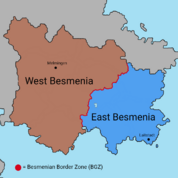Besmenian division
The Besmenian division or division of Besmenia refers to the existence of two Besmenian states in the area of Besmenia between 1920 and reunification in 1949. It was a result of the Besmenian Civil War.
The division was decided by the Heraldstein-Müller Treaty on March 1, 1920, began with the entry into force of the East Besmenian Constitution on July 2, 1920 and ended on September 14, 1949 with the accession of the Kingdom (West Besmenia) to the Federal Republic (East Besmenia).
Prehistory of the division
The basis of the division was the organization Besmenian Freedom Fighters (BEFK), which fought against the Royal Army in the civil war to introduce democracy in Besmenia. The Kingdom of Besmenia surrendered on January 18, 1920, making the BEFK the winners. After a peace treaty was signed the same day, negotiations were held for the future of Besmenia. The division was decided with the Heraldstein-Müller contract on March 1, 1920. This contract provided for the establishment of the new state of the Federal Republic of Besmenia and the incorporation of the federal states of Summingen, Metakumburg and Trissia into the new state. The Federal Republic also received the eastern part of the state of Lemberland.
Relation between East and West Besmenia
The relationship between the two states was relatively pleasant until Karl Ochsenbein took office. With the establishment of the dictatorship in West Besmenia, the relationship between the two countries became complicated. East Besmenia criticized West Besmenia for violating freedom of expression under Ochsenbein's regime. The relationship reached its lowest point in 1926 when West Besmenia militarily closed and guarded the border to East Besmenia. East Besmenia criticized very hard West Besmenia for allowing the shooting of border refugees.
The East Besmenian Prime Minister Heinz Dimmler envisaged a Besmenian reunification led by the Federal Republic as his goal during the 1930s.

